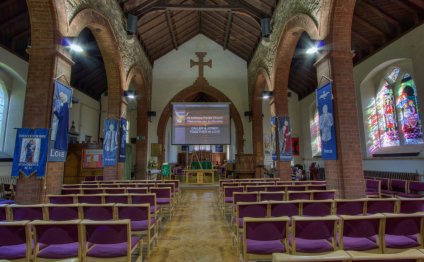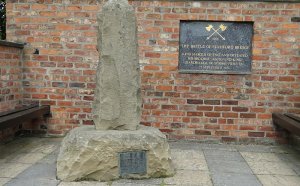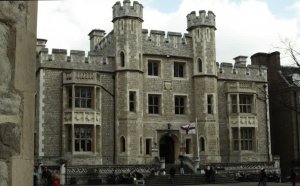
William of Conqueror
 William I byname William the Conqueror or William the Bastard or William of Normandy, French Guillaume le Conquérant or Guillaume le Bâtard or Guillaume de Normandie (born c. 1028, Falaise, Normandy [France]—died Sept. 9, 1087, Rouen), duke of (as William II) from 1035 and king of England from 1066, one of the greatest soldiers and rulers of the Middle Ages. He made himself the mightiest noble in France and then changed the course of England’s history by his conquest of that country.
William I byname William the Conqueror or William the Bastard or William of Normandy, French Guillaume le Conquérant or Guillaume le Bâtard or Guillaume de Normandie (born c. 1028, Falaise, Normandy [France]—died Sept. 9, 1087, Rouen), duke of (as William II) from 1035 and king of England from 1066, one of the greatest soldiers and rulers of the Middle Ages. He made himself the mightiest noble in France and then changed the course of England’s history by his conquest of that country.
Early years
William was the elder of the two children of Robert I of Normandy and his concubine Herleva (also called Arlette, the daughter of a tanner or undertaker from the town of Falaise). Sometime after William’s birth, Herleva was married to Viscount Herluin, by whom she bore two sons—including Odo, the future bishop of Bayeux—and a daughter. In 1035 Robert died while returning from a pilgrimage to Jerusalem, and William, his only son, whom he had nominated as his heir before his departure, was accepted as duke by the Norman magnates and by his overlord, King Henry I of France.
![Bayeux Tapestry: English axman in combat with Norman cavalry [Credit: Giraudon/Art Resource, New York]](/img/bayeux_tapestry_english_axman_in_combat.jpg) William and his friends had to overcome enormous obstacles, including William’s illegitimacy (he was generally known as the Bastard) and the fact that he had acceded as a child. His weakness led to a breakdown of authority throughout the duchy: private castles were erected, public power was usurped by lesser nobles, and private warfare broke out. Three of William’s guardians died violent deaths before he grew up, and his tutor was murdered. His father’s kin were of little help, since most of them thought that they stood to gain by the boy’s death. His mother, however, managed to protect him through the most dangerous period. These early difficulties probably contributed to William’s strength of purpose and his dislike of lawlessness and misrule.
William and his friends had to overcome enormous obstacles, including William’s illegitimacy (he was generally known as the Bastard) and the fact that he had acceded as a child. His weakness led to a breakdown of authority throughout the duchy: private castles were erected, public power was usurped by lesser nobles, and private warfare broke out. Three of William’s guardians died violent deaths before he grew up, and his tutor was murdered. His father’s kin were of little help, since most of them thought that they stood to gain by the boy’s death. His mother, however, managed to protect him through the most dangerous period. These early difficulties probably contributed to William’s strength of purpose and his dislike of lawlessness and misrule.
Ruler of Normandy
By 1042, when William reached his 15th year, was knighted, and began to play a personal part in the affairs of his duchy, the worst was over. But his attempts to recover rights lost during the anarchy and to bring disobedient vassals and servants to heel inevitably led to trouble. From 1046 until 1055 he dealt with a series of baronial rebellions, mostly led by his kinsmen. Occasionally he was in great danger and had to rely on Henry of France for help, but it was during these years that William learned to fight and rule. A decisive moment came in 1047, when Henry and William defeated a coalition of Norman rebels at Val-ès-Dunes, southeast of Caen, a battle in which William first demonstrated his prowess as a warrior.
![William I: detail from the Bayeux Tapestry, 11th century [Credit: Courtesy of the Phaidon Press Ltd., publishers of The Bayeux Tapestry edited by Sir Frank Stenton]](/img/william_i_detail_from_the_bayeux.jpg) William soon learned to control his youthful recklessness. He was always ready to take calculated risks on campaign and to fight a battle, but he was not a flamboyant commander. His plans were simple, his methods direct, and he ruthlessly exploited any opportunity. If he found himself at a disadvantage, he withdrew immediately. He showed the same qualities in his government. He never lost sight of his aim to recover lost ducal rights and revenues, and, although he developed no theory of government or great interest in administrative techniques, he was always prepared to improvise and experiment.
William soon learned to control his youthful recklessness. He was always ready to take calculated risks on campaign and to fight a battle, but he was not a flamboyant commander. His plans were simple, his methods direct, and he ruthlessly exploited any opportunity. If he found himself at a disadvantage, he withdrew immediately. He showed the same qualities in his government. He never lost sight of his aim to recover lost ducal rights and revenues, and, although he developed no theory of government or great interest in administrative techniques, he was always prepared to improvise and experiment.
He was moral and pious by the standards of the time, and he acquired an interest in the welfare of the Norman church. He made his half brother Odo bishop of Bayeux in 1049 at the age of about 16; as bishop, Odo combined the roles of nobleman and prelate in a way that did not greatly shock contemporaries. Although Odo and the other bishops appointed by William were not recognized for their spirituality, they strengthened the church in Normandy by their pious donations and administrative skill. Presiding over numerous church councils, William and his bishops passed important legislation against simony (the selling of church offices) and clerical marriage. He also welcomed foreign monks and scholars to Normandy, including Lanfranc of Pavia, a famous master of the liberal arts, who entered the monastery of Bec about 1042 and was made abbot of Caen in 1063. William endowed several monasteries in his duchy, significantly increasing their number, and introduced the latest currents in reform to Norman monasticism.
According to a brief description by an anonymous author—who borrowed extensively from Einhard’s biography of Charlemagne (Vita Karoli Magni; “Life of Charles the Great”)—William was just above average height and had a robust, thickset body. Although he was always sparing of food and drink, he became fat in later life. He had a rough bass voice and was a good and ready speaker. Writers of the next generation agree that he was exceptionally strong and vigorous. He was a hunter and soldier, fierce and despotic, and generally feared; uneducated, he had few graces but was intelligent and shrewd and soon obtained the respect of his rivals.
New alliances
After 1047 William began to participate in events outside his duchy. In support of King Henry and in an attempt to strengthen his southern frontier and expand into the western county of Maine, he fought a series of campaigns against Geoffrey Martel, count of Anjou. But from 1052, when Henry and Geoffrey made peace and a serious rebellion began in eastern Normandy, until 1054 William was again in grave danger. During this period he conducted important negotiations with his cousin Edward the Confessor, king of England, in which he was named heir to the English throne, and took a wife.
Video on topic: William of Conqueror



Share this Post
Related posts
History of William the Conqueror
In September 1066, a Norman duke called William the Bastard landed in Sussex, determined to lay claim to the British Isles…
Read MoreTower of London Castle
The Tower of London is admired for its architecture and its history but it is most remembered for the bloody executions…
Read More












